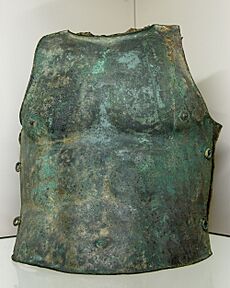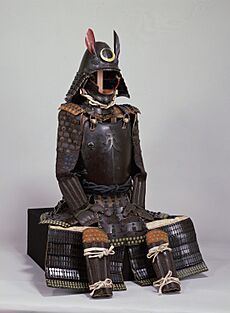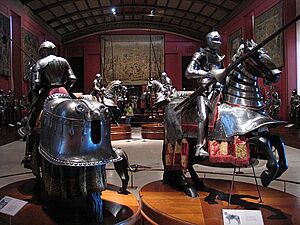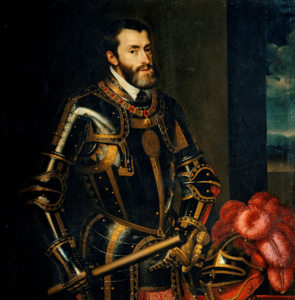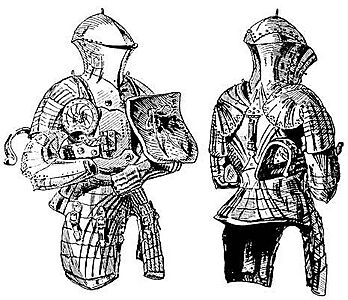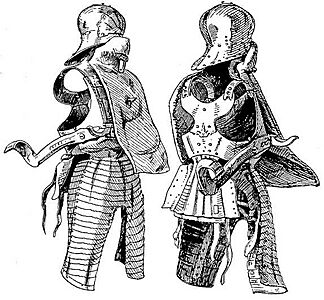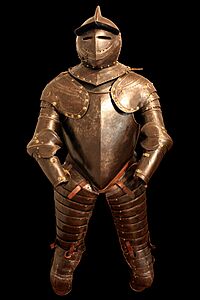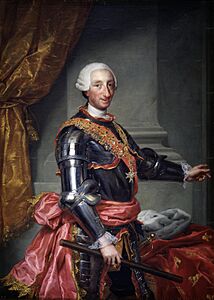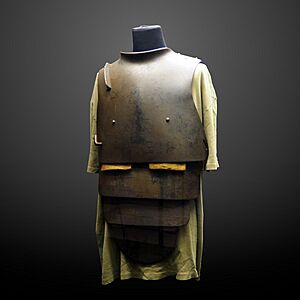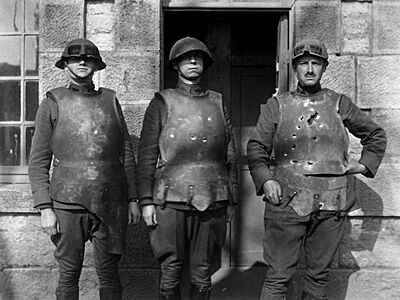Plate armour facts for kids
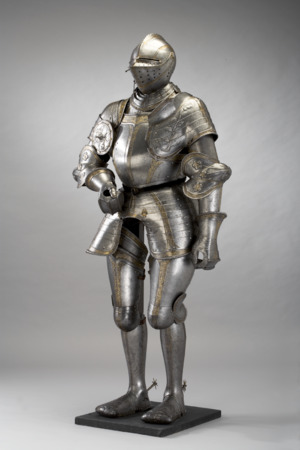
Plate armour is a type of protective clothing from history. It was made from strong metal plates, like bronze, iron, or steel. The most famous type is the suit of armour, which covered a person completely.
Full steel plate armour became popular in Europe during the Late Middle Ages. This was especially true during the Hundred Years' War. It grew from earlier types of armour, like the "coat of plates," which people wore over mail (chainmail) in the 1300s.
In Europe, plate armour was at its best in the late 1400s and early 1500s. A full suit of armour, sometimes called a panoply, was common at the very end of the Middle Ages and during the Renaissance period. People often think of it with "medieval knights" because of the special armour used for jousting in the 1500s.
Knights and soldiers wore full suits of armour in many famous battles. These included the Burgundian Wars, Wars of the Roses, and parts of the Hundred Years' War. Heavy cavalry, like cuirassiers, wore the most armour. But even foot soldiers, like the Swiss mercenaries, started wearing lighter "three-quarters" armour that left their lower legs open.
Plate armour started to be used less in the early 1600s. This was because muskets became more common and powerful. Muskets could shoot through armour from far away. After the mid-1600s, plate armour was mostly just a breastplate (chest armour). However, the Polish Hussars still used a lot of plate armour. Later, in the Napoleonic Wars, breastplates became important again to protect against shrapnel (small metal pieces from explosions). In World War II, soldiers used steel plates sewn into flak jackets. Today, modern body armour uses lighter, stronger materials like fibre-reinforced plastic.
Mail armour was a common type of protection from the 800s to the 1200s. It was still worn under plate armour until the 1400s. Mail was made from hundreds of small, linked metal rings, usually iron or steel, held together by rivets. This design allowed it to fit the body well, making it comfortable. Mail armour was good at stopping cuts and thrusts from swords. It was not as good against blunt weapons like clubs. Common mail items included hooded cloaks, gloves, and even shoes. Mail armour was so popular in Europe from the 900s to the 1200s that this time is sometimes called the "age of mail."
Contents
Early History of Armour
Early forms of plate armour, made of bronze, protected the chest and legs. The ancient Greeks used these as early as the late Bronze Age. The Dendra panoply, for example, covered the whole torso, shoulders, and neck. Later, the muscle cuirass became popular in classic antiquity.
The Roman empire used plate armour called the Lorica segmentata from the 1st century BC to the 4th century AD.
Later, around the late 1200s, single metal plates were used again in Europe. These plates protected joints and shins and were worn over a mail shirt. Slowly, more and more plate components of medieval armour were added. They covered more parts of the body, and even horses wore plate armour called barding. Armour makers learned to make flexible plates for parts of the body that needed to move. They also learned to fit armour perfectly to each person.
A high-quality, custom-made suit of armour was very expensive. Only wealthy people who were serious about fighting or jousting could afford it. Most soldiers wore a mix of different armour pieces, and mail armour was still very important.
Plate Armour in Japan
In Japan, iron plate chest pieces (tankō) and helmets were made during the Kofun period (250–538 AD). Plate armour was also used in Japan during the Nara period (646–793 AD).
During the Sengoku period (1467–1615), Japan needed a lot of armour for its growing armies of foot soldiers (ashigaru). Simple, mass-produced chest armour (dō) and helmets (kabuto) were made.
In 1543, the Portuguese brought matchlock firearms to Japan. As Japanese gunsmiths started making many firearms, the older lamellar armour used by samurai became less common. Japanese armour makers began creating new types of armour from larger iron plates and plated leather. This new armour was called tōsei gusoku, meaning "modern armour." A type of gusoku that covered the front and back with a single iron plate, similar to Western plate armour, was called nanban dou gusoku ("Western style gusoku"). Some samurai used this. Japanese armour makers even designed "bullet-tested" plate armour called tameshi gusoku. This allowed soldiers to keep wearing armour even with many firearms being used in the late 1500s.
Warfare in Japan ended in the 1600s. However, samurai continued to use plate armour until the samurai era ended in the 1860s. The last known use of samurai armour was in 1877 during the Satsuma rebellion.
Plate Armour in the Late Middle Ages
By about 1420, full suits of plate armour were common in Europe. A complete suit included many parts: a helmet, a neck guard (gorget), shoulder pieces (spaulders), arm guards, gauntlets (gloves), a cuirass (chest and back plate), and leg and foot protection. The most complete sets, called garnitures, were often made for jousting. They included extra pieces that could be swapped for different uses, like fighting on foot or on horseback. By the end of the Middle Ages, even foot soldiers could afford some pieces of plate armour. Making armour was a big and profitable business during the Middle Ages and the Renaissance.
A full suit of well-made steel plate armour weighed about 15 to 25 kilograms (33 to 55 pounds). The person wearing it could still move very well. They could jump, run, and move freely because the weight was spread evenly over their body. The armour had joints and covered the entire body from neck to toe. In the 1400s and 1500s, soldiers in plate armour were the most important part of every army. Large groups of armoured soldiers, sometimes thousands strong, fought on foot alongside archers. This was common in Western European armies, especially during the Hundred Years War and the Italian Wars.
The best armour makers in Europe were from Northern Italians, especially Milan, and Southern Germans. They had slightly different styles. But armour styles spread across Europe as craftsmen moved around. For example, the Renaissance Greenwich armour was made near London by craftsmen from Italy, Flanders, and Germany. The Ottoman Empire also used a lot of plate armour, often mixed with mail.
How Armour Changed Weapons
Plate armour gave excellent protection against sword cuts and spear thrusts. It also offered good defense against blunt weapons.
Because armour was so good, weapon makers had to invent new ways to attack. While armour stopped cuts, its weak spots could be hit by thrusting weapons like estocs (long, thin swords), poleaxes, and halberds. The effect of arrows and bolts on plate armour is still debated. The rise of plate armour in the 1300s also led to new polearms. These weapons were designed to hit hard and focus their power on a small area, causing damage through the plate. Maces, war hammers, and poleaxes were used to cause blunt force injuries through armour. A strong hit to the head could cause a concussion, even if the armour was not broken.
Armour with ridges, called "fluted plate," looked nice and also made the armour stronger against hits. To protect against weak spots, most warriors wore a mail shirt under their plate armour. Later, full mail shirts were replaced with smaller mail patches, called gussets, sewn onto a padded jacket. Small round plates called besagews also protected the armpit area.
Renaissance Armour
German "Maximilian armour" from the early 1500s had many ridges and decorative designs. This was different from the smoother armour of the 1400s. This time also saw the use of closed helmets. During the early 1500s, helmet and neck guard designs were improved, leading to the "Nürnberg armour," which was often a work of art.
As firearms became better and more common, full armour became less useful in battle. Full suits were then mostly made for jousting, which continued to develop as a sport. The decoration on fine armour greatly increased during this time, making it much more expensive. Very fancy plate armour was made for kings and queens and very rich people. This highly decorated armour is often called "parade armour." It was worn for special events, but sometimes also in battle. For example, the steel plate armour made for Henry II of France in 1555 was covered with detailed designs and colours.
Making such armour required armourers to work with artists or be artists themselves. They also used designs from prints. Daniel Hopfer was an armour etcher who helped develop etching as a way to make prints. Other artists, like Hans Holbein the Younger, designed armour. Filippo Negroli, a famous armourer from Milan, was known for his amazing sculpted designs on armour.
-
Painting of Charles V, Holy Roman Emperor (around 1605), showing a fancy Renaissance suit of armour.
Infantry Armour
Lighter plate armour, usually just a breastplate, a helmet (like a burgonet or morion), and gauntlets, became popular among soldiers in the 1500s. This mass-produced armour, called "munition armour," was cheaper than full suits. It was often heavier and made of lower-quality metal than the fancy armour for commanders.
Jousting Armour

Special armour for jousting was made in the late 1400s and 1500s. It was much heavier, sometimes weighing as much as 50 kilograms (110 pounds). This armour was not for free combat, so it did not need to allow much movement. The only limit was how much a warhorse could carry.
The medieval joust started from the fighting methods of heavy cavalry in the High Middle Ages. By the 1400s, jousting had become a sport (hastilude) and was less about real warfare. It used separate, special armour and equipment.
In the 1490s, Emperor Maximilian I worked hard to improve the sport. He was even called "The Last Knight." Rennen and Stechen were two types of jousting developed in the 1400s and practiced through the 1500s. The armour for these styles was called Rennzeug and Stechzeug. The Stechzeug became extremely heavy. It made it almost impossible for the rider to move. In its latest forms, it looked more like an armour-shaped cabin built into the horse armour than a functional suit of armour. These very heavy jousting armours from the 1500s led to the wrong idea that all "medieval armour" was heavy and clumsy. This idea was made popular by Mark Twain's book A Connecticut Yankee in King Arthur's Court.
The very heavy helmets of the Stechzeug were needed because the goal was to knock off the opponent's helmet crest. This meant the lance often hit the helmet directly.
In contrast, the Rennen was a lighter type of joust. The goal was to hit the opponent's shield. The special Rennzeug was made at Maximilian's request. He wanted a more agile jousting style compared to the heavy "full contact" Stechen. In the Rennzeug, the shield was attached to the armour with springs and would pop off when hit.
Plate Armour in the Early Modern Period
Plate armour was widely used by most armies until the end of the 1600s. Both foot soldiers and mounted troops, like cuirassiers and Polish hussars, wore it. The infantry armour of the 1500s developed into the "Savoyard" type of three-quarters armour by 1600.
Full plate armour was expensive to make. So, it remained limited to the richer parts of society. Lavishly decorated suits of armour stayed fashionable for nobles and generals in the 1700s. This was long after they were no longer useful in battle because of cheap muskets.
As powerful firearms became more common, most armour became useless. The increasing power of guns and the rise of large armies meant that more parts of plate armour were removed. This made troops cheaper and more mobile. Leg protection was the first to go, replaced by tall leather boots. By the early 1700s, only field marshals, commanders, and royalty wore full armour on the battlefield. It was more a sign of their rank than for actual protection. It was still fashionable for kings to be shown in armour during the first half of the 1700s. However, even this tradition ended. For example, a portrait of Frederick the Great in 1739 shows him in armour. But a later painting from around 1760 shows him as a commander without armour.
-
Christian the Younger of Brunswick wearing cuirassier armour (1620).
-
Portrait of Charles III of Spain in a suit of armour (1761).
Modern Body Armour
Body armour briefly returned during the American Civil War, with mixed results. In World War I, both sides tried out shrapnel armour. Some soldiers used their own special ballistic armour, like the American Brewster Body Shield. However, none were made in large numbers. The heavy cavalry armour (cuirass) used by the German, British, and French empires during the Napoleonic Wars was still used in the first months of World War I. French cuirassiers even went to battle near Paris wearing armour. The cuirass is the last type of plate armour that came from the Late Middle Ages. Meanwhile, makeshift steel armour to protect against shrapnel and early ballistic vests started to be developed from the mid-1800s until today.
The term "flak jacket" first referred to armour made by the Wilkinson Sword company during World War II. It was designed to protect Royal Air Force (RAF) airmen from flying debris and shrapnel. The Red Army also used steel body armour, usually chest plates, for combat engineers and assault soldiers.
After World War II, steel plates were replaced by vests made from synthetic fibres in the 1950s. These were made of materials like boron carbide or aluminium oxide. They were given to crews of low-flying aircraft during the Vietnam War. The synthetic fibre Kevlar was invented in 1971. Most ballistic vests since the 1970s use Kevlar, sometimes with extra "trauma plates" to reduce injury from blunt force. These plates can be made of ceramic, metal (steel or titanium), or synthetic materials.
See also
 In Spanish: Armadura de placas de acero para niños
In Spanish: Armadura de placas de acero para niños
- Ballistic vest
- Components of medieval armour
- Mirror armour
- Plated mail
- Proofing of armour



